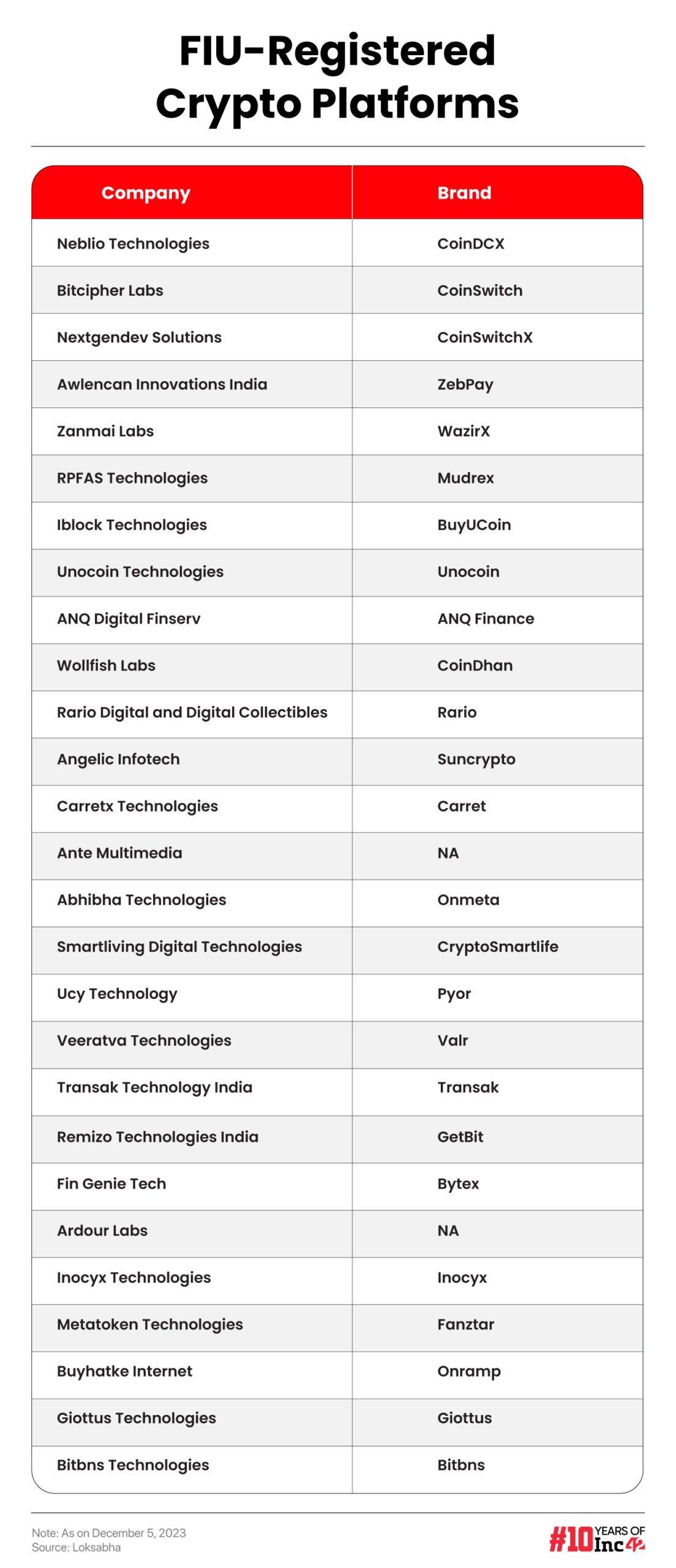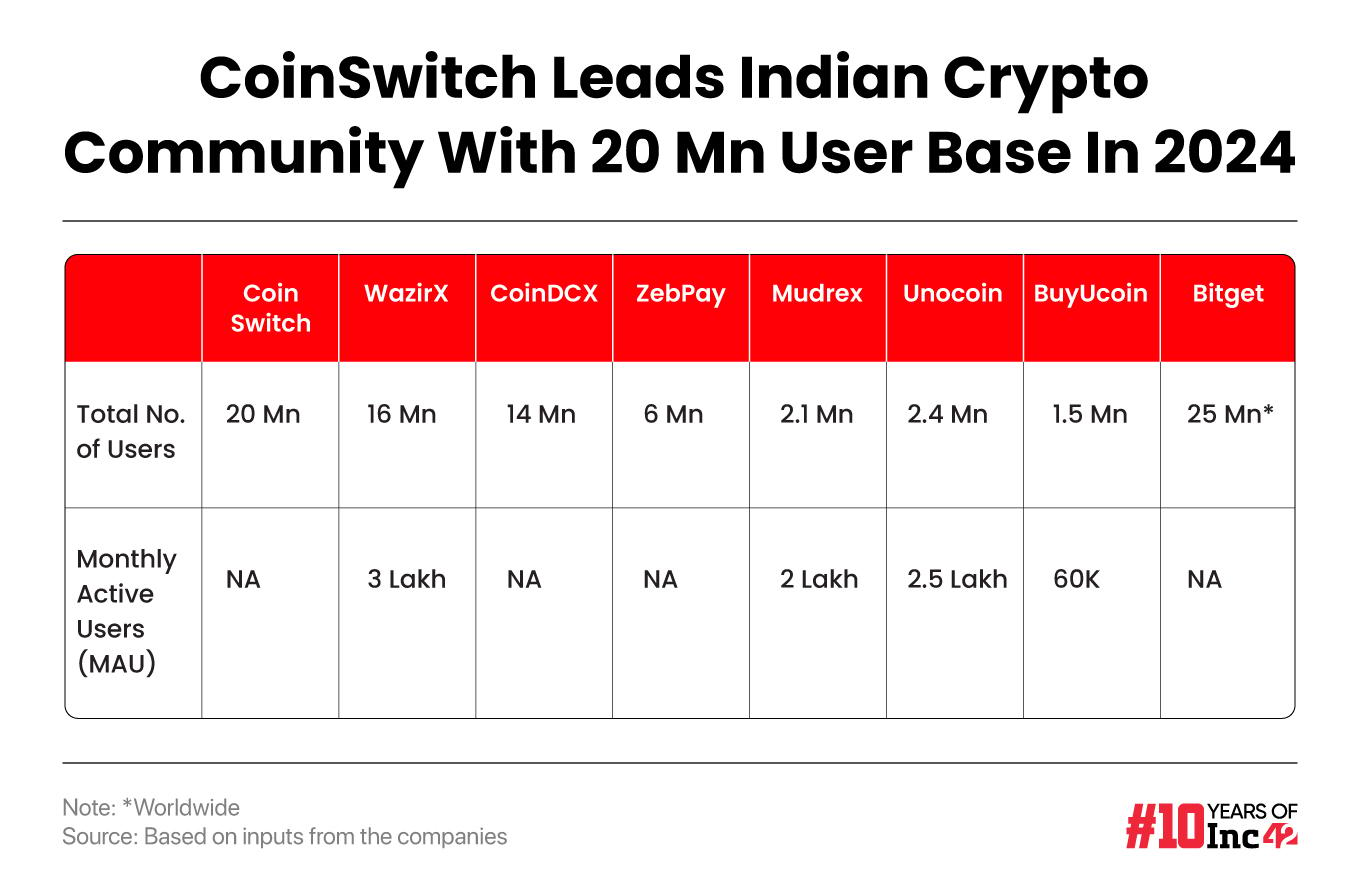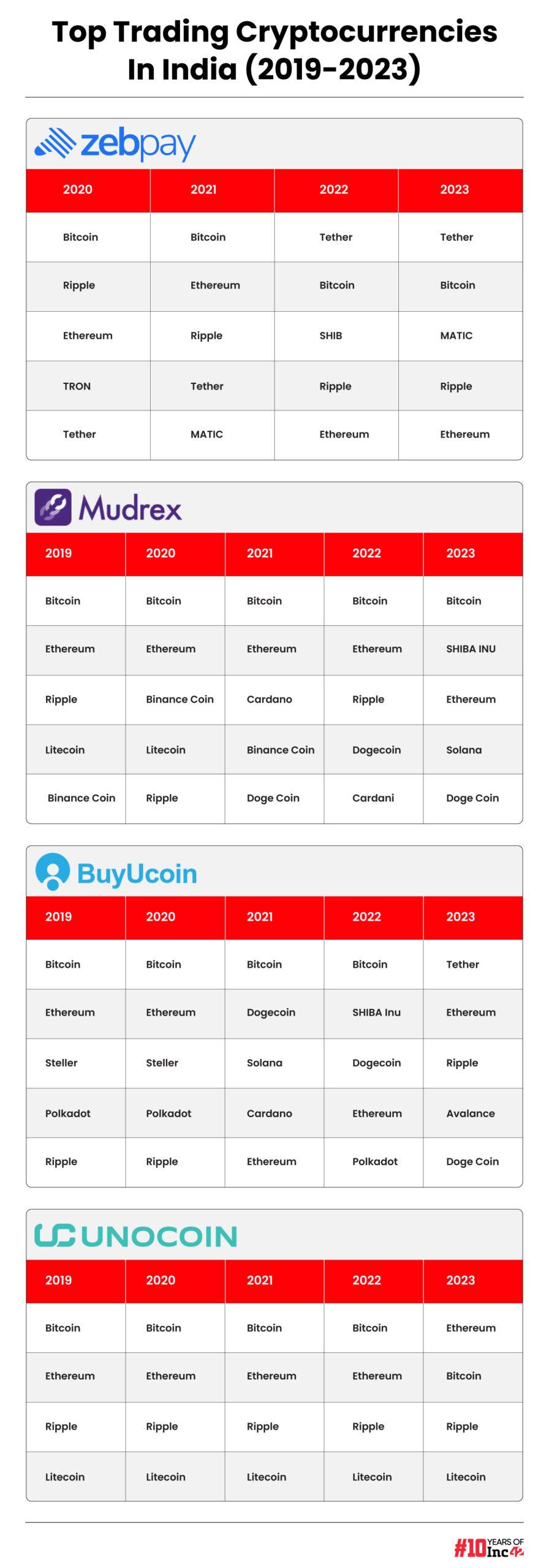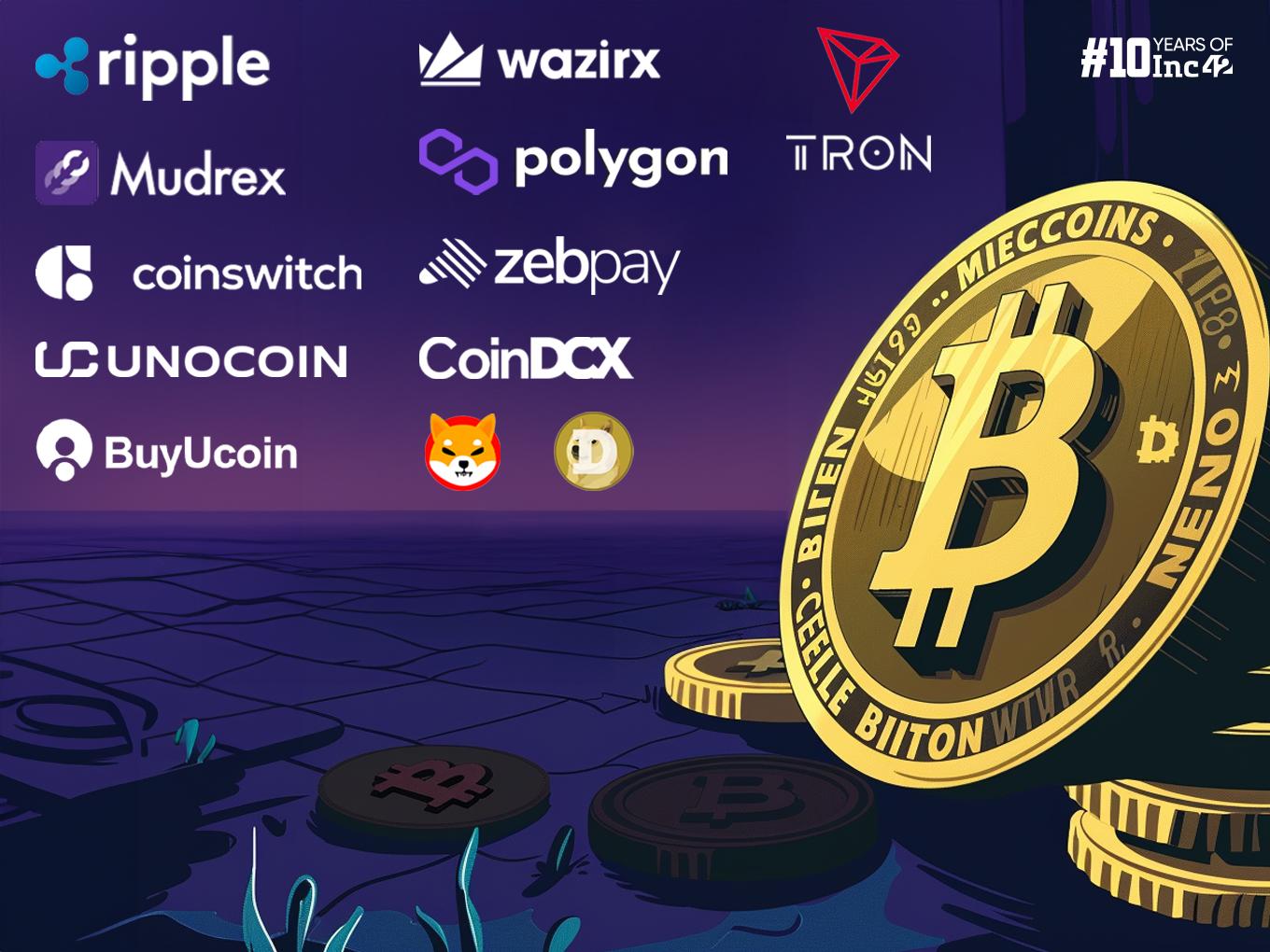After a decline in 2022 due to three black swan events, Indian crypto exchanges are now stepping up from recovery to growth phase
CoinSwitch has emerged as the largest crypto exchange in India in 2024 with 20 Mn users, while ZebPay and WazirX have slid to fourth and second spots, respectively
Bitcoin’s position has weakened on multiple Indian exchanges, where it is now trading at No. 2 or No. 3
Bitcoin (BTC) made a stunning comeback at long last, hitting more than $73K in March 2024, soaring past its previous peak of almost $69K in November 2021 and clocking a 300% jump from November 2022, when it slumped below $20K. Given its remarkable rally, the combined market cap of the cryptocurrencies in circulation shot up to $2.5 Tn, just 10% short of the all-time high of $2.8 Tn, as per industry data.
Crypto enthusiasts across the globe are delighted. The tide has presumably turned after the 2022 downturn and a wave of bankruptcies following an elaborate scam by Sam Bankman-Fried’s FTX, the world’s third-largest cryptocurrency exchange by volume. Investors lost billions of dollars in bank-run-like situations at the time, and virtual digital assets (VDAs) appeared to be tainted for good. In the wake of the huge financial fraud, many central banks played the stern gatekeeper, safeguarding investor money from scams and manipulation.
Interestingly, crypto’s rapid rise might not have been possible without the launch of Bitcoin ETFs (approved by the U.S. SEC to ensure gains from price movements by trading ETF shares without owning the digital asset), the UK’s nod for crypto-backed exchange-traded notes (eETNs), and the phenomenal Bitcoin halving in April 2024 that would control its supply and push the price up. In fact, a few price prediction systems estimate BTC to breach $84K by October this year.
That is not to say that cryptos, in general, and BTC, in particular, have shaded their infamous volatility. By the time we are publishing this article, BTC has dropped $66K, and the flourish chart shows price fluctuations similar to standard stock markets. But unlike the previous bull run in 2021, primarily pushed by amateur traders looking to get rich overnight, the crypto market now has the imprimatur of financial regulators.
This indicates the emergence of a mature landscape where stakeholders are ready to abide by more stringent policies and the market is no longer shunned by FIs and professional wealth managers. In the US alone, more than $7 Bn had been initially invested in new crypto products, according to Bloomberg data. The inflow will likely increase as the US Federal Reserve indicates interest rate cuts in H2 2024 and more investors turn to riskier assets for better returns.
India Is Witnessing A Surge, Too; Will It Continue?
In India, crypto exchanges have also witnessed a giant leap in trading volume despite existing hurdles and the absence of a well-structured regulatory framework. The latter has been a work in progress since 2021, although the country has set up a clear-cut tax structure and a well-defined registration-and-reporting framework, eliminating many of the ambiguities. This has helped build a more favourable regulatory climate, leading to a level playing field.
According to the latest report by Hashed Emergent, a web3 venture capital firm, the country claimed the top spot for on-chain adoption in 2023 among 150+ nations, saw 1K+ Web3 startups (built on blockchain technology and user-controlled) thriving and set up more than 35 Mn crypto trading accounts on top Indian exchanges.
India now ranks among the top five countries in peer-to-peer (P2P) crypto trading and 75% of Indian users opting for centralised exchanges (CEXs) are aged below 35, a demographic dividend no country can ignore. After all, the future can be all about decentralisation, whether it is currency or finance, and young Indians can easily leverage these benefits for a long time.
All this despite the overwhelming tax burden and the stringent regulations that India has imposed on the crypto industry in recent years. Since 2022, the country has levied a 30% tax on the earnings from digital asset transfers (including cryptocurrencies, non-fungible tokens or NFTs and more), a 1% TDS (tax deducted at source) on the buyer’s payment if it surpasses the threshold and no deduction is allowed except the acquisition cost. A person receiving crypto assets as a gift is liable to pay taxes, but a VDA loss cannot offset any other income.
The Reserve Bank of India also threw a spanner in the works in April 2018, prohibiting banks and other regulated financial entities from dealing with crypto exchanges. The Supreme Court set aside the RBI order in March 2020, but more than a dozen crypto startups had to cease operations by then.
The latest mandate came in December 2023, when India banned nine offshore crypto exchanges citing ‘non-compliance’ with local tax and anti-money laundering laws. According to the Prevention of Money Laundering ACT (PMLA) 2002, VDA service providers must register with the Financial Intelligence Unit (FIU operates under the finance ministry), which acts as a reporting entity for the control, administration and safekeeping of VDAs.
The ban on these global platforms sent Indian users rushing to homegrown players like CoinSwitch and CoinDCX etc. In the absence of big names like Binance, Coinbase and KuCoin, Indian crypto exchanges were once again holding sway and business is booming (more on that later).
Several exchanges such as Binance and KuKoin recently registered with FIU-India and received in-principle approval. The total number of VDA SPs has now increased to 47 and they adhere to the tax laws outlined in the Finance Act, 2022. However, the entire list has yet to be made public.

The pecking order has also changed in recent years. Although most top exchanges remain operational, there has been a notable shift in market share. For instance, ZebPay, India’s largest crypto exchange (by users, volume) until 2018, slipped to the fourth spot in 2024. WazirX, in spite of its fallout with Binance and the ongoing probe by the Enforcement Directorate under FEMA and PMLA, it has retained the second spot (by userbase) in the Indian market.

Inc42 spoke with nearly a dozen crypto platforms in India to comprehend the current landscape, the changes witnessed in recent years, upcoming trends and whether the industry may return to pre-taxation times.
From Recovery To Growth: The Crypto Industry In India Has Come A Long Way
Asked whether the enthusiasm around the recent surge in crypto could eventually collapse under the tax burden, Shivam Thakral, cofounder and CEO of BuyUcoin, said that the Indian crypto market went through a period of adjustment and adaptation after the tax laws came into effect in 2022 and heavily impacted the industry. Initially, these regulatory measures created uncertainties and cautious sentiment among market participants.
“However, as regulatory clarity improved and users gained confidence in compliance frameworks, the market showed resilience and began to recover. This underscores the growing acceptance and integration of cryptocurrencies within the Indian financial ecosystem, paving the path for sustained growth and innovation,” Thakral told Inc42.
Most founders of crypto startups also believe that 2024 will mark the industry’s growth phase and may lure investors with new products like derivatives, spurring a further surge in trading activity. Even SEBI is now reportedly mulling to regulate the same.
According to Edu Patel, founder and CEO of Mudrex, crypto trading volume in India peaked between 2019 and 2021 but saw a decline in the next two years due to three black swan events.
Along with those came rising inflation, high interest rates (the RBI’s hawkish policy stance to keep inflation under control) and macroeconomic headwinds, leading to a global slump in trading volumes.
“However, there was a [more sustainable] surge in 2024, especially in March, when we recorded the highest trade volume. We have witnessed consistent growth ever since,” added Patel.
Rajagopal Menon, VP at WazirX, said the government’s mandate on territory-agnostic tax compliance and the ban imposed on overseas crypto majors created a level playing field.
“Following the announcement, domestic exchanges witnessed a surge in volume. WazirX saw a 250% increase in deposits and a 100% rise in transaction value within a week. Subsequently, a few foreign exchanges have stepped forward to comply with Indian tax laws, which is a fair move,” he added.
The tax pushback initially landed local exchanges in deep trouble. According to a study released by the Delhi-based think tank Esya Centre, the heavy tax burden on all transactions of virtual assets saw a cumulative trade volume worth INR 32K Cr shift from Indian crypto exchanges to foreign ones between February and October 2022.
Most Indian users shifted their base to international platforms like Binance, OKX, Kraken and Coinbase during that period. However, with the ban on global crypto exchanges and the inaccessibility of their apps and platforms, most active traders had no choice but to shift back to Indian platforms.
ZebPay’s CEO, Rahul Pagidipati, also believed the second crypto rally would be more sustainable than before. “The previous crypto cycle saw a massive inflow of retail investors on ZebPay. It was primarily due to the rise in crypto exchanges and the positive market sentiment in 2020-2021.
Macroeconomic stimulus such as a reduction in interest rates during this period led to a rapid rise in participation in the financial markets sector. While the market corrected in the year 2021-22, we have seen a healthy rise in participation since then and we anticipate FY 2024-25 to be one of the best years in this market cycle,” he added.
Bitcoin Is No Longer The Big Boss Of Crypto In India
Could that be a landmark in the history of cryptocurrencies? Not globally, of course, and not right now. Bitcoin still accounts for more than 50% of the crypto market cap, and India is no exception. But a look at the major Indian exchanges (ZebPay, Mudrex, BuyUcoin and Unocoin) shows that BTC has traded at No. 2 on many occasions.
However, the price performances of the other two prominent altcoins – Ethereum and Ripple – have seen enough fluctuations and downturns. In fact, they have yet to make it to the top five most-transacted coins on WazirX.
Although WazirX did not provide year-wise details, Menon said that the top five tokens between 2019 and 2023 were Bitcoin, Shiba Inu, USDT, Dogecoin and WRX (the last one is the token introduced by WazirX).
Tether, a cryptocurrency stablecoin launched by the eponymous brand, is fiercely fighting Bitcoin. In the current calendar year (2024), the value of Bitcoin transactions on WazirX has reached $8.2 Bn, while Tether has clocked more than $7.7 Bn. Shiba Inu, Dogecoin and WRX recorded $5 Bn, $3.3 Bn, and $3.2 Bn, respectively.
According to Thakral of BuyUcoin, the Indian landscape featuring top-traded cryptocurrencies underwent significant changes during 2019-2023. In 2019, established cryptocurrencies such as Bitcoin, Ethereum, Ripple, Litecoin and Bitcoin Cash (BCH) dominated the market due to their global recognition and high liquidity. But the years that followed saw the rise of new contenders amid shifts in market narratives.
The Hashed Emergent report still rates Bitcoin and Ethereum as the most favoured assets among Indian traders. But altcoins like Chainlink (an Ethereum token), Matic (by Polygon), Cardano/ADA and Polkadot/DOT have gained prominence due to varied preferences and the need for asset diversification.
The latter half of 2023 saw the emergence of AI and GPU-based projects particularly Fethch.ai, Render, Akashnet, Bittensor, SingularityNet. These trends underscore the maturation and the speed of building in the blockchain industry, said Thakral.
The rise of meme coins like Shiba Inu and Dogecoin in India is surprising, too. Meme ‘stonks’ gained prominence in the heady days of 2021 when the YOLO mindset (and Covid subsidies) pushed newbie retail investors towards counter-intuitive risk-taking.
But the question is: Does the Indian crypto community really think these altcoins have good investment potential? Or is it simply indulging in these VDAs based on speculative anticipation? Getting rid of BTC may not be possible just yet. Meanwhile, celebrity advocates of meme coins like Elon Musk (he promoted Dogecoin several times to push its price) may try to make them worthwhile for investors looking at less-explored assets.
Still, routinely investing in meme coins for good returns is a far cry. Right now, it is mostly wait-and-watch for retail investors. Although hero investors in meme coins like the Roaring Kitty are back on social media (a Fortune report says), will they be able to lead crypto’s comeback season and attract more altcoin believers?

Can Crypto In India Push Past Existing Hurdles To Kickstart FY25?
The Internet and Mobile Association of India (IAMAI), an industry lobby under which the Blockchain and Crypto Assets Council (BACC) operated since its inception in 2017, initially fought and won against the RBI gag order. However, in the face of mounting regulatory conflicts, IAMAI distanced itself and dismantled the crypto body in July 2022.
Undeterred by this setback, major crypto exchanges, startups and other stakeholders across the Web3 verticals banded together to form a new entity – the Bharat Web3 Association (BWA) – in November 2022. This new lobby is not only continuing the fight for the industry but also accelerating efforts to raise awareness, set industry standards, nurture the local talent pool and protect consumers’ interests in India.
In April this year, the BWA took a significant step by introducing a set of guidelines for listing tokens on member VDA platforms. These address all aspects of VDAs — assets tokenised on existing blockchains or units of value generated on the blockchain or other distributed ledger technology (DLT) networks.
It is important to note that tokens involved in Airdrops (unsolicited deposits in numerous wallets for marketing), NFTs and ICOs/IEOs/IDOs (similar to IPOs in traditional financial markets), as well as standard disclosures outlining associated risks, fall outside the scope of these guidelines, showcasing the industry’s commitment to self-regulation.
Although the general elections are yet to be over, the BWA has put forward its recommendations for the upcoming Financial Bill in June/July 2024. Additionally, VDA platforms are expected to follow existing operational frameworks and protocols during the token listing, including announcement dates, comprehensive project disclosures, safeguards against market abuses, technical evaluations and thorough staging and testing before public offerings.
Among the key recommendations are:
- Recognising the Web3 sector under startup initiatives
- Forming a task force with members from the industry for regulatory requirements
- Reducing the rate of TDS on transfer of VDAs to 0.01% from 1%
- Re-examining the flat rate of 30% applicable to incomes from VDA transfers
- Allowing offsetting of losses
When asked about the potential impact of these guidelines, Sathvik Vishwanath, the cofounder and CEO of Unocoin, emphasised that regulatory clarity and investor confidence would be the key growth drivers in the crypto space. It will not only foster innovation and entrepreneurship within the industry but also pave the way for sustainable development. In fact, collaboration between industry stakeholders and regulatory bodies is crucial to create a conducive environment for growth.
Jyotsna Hirdyani, head of South Asia at Bitget, concurred, adding that the market is poised for expansion as institutional interest continues to grow and technological innovations advance.
As the Indian crypto community strides through regulatory hurdles and embraces innovation, collaboration between stakeholders and regulatory bodies remains critical for sustained growth and development in this dynamic ecosystem.
Can crypto in India overcome the hurdles after the recent rally and a modicum of stability gained over the years? Or will it continue to struggle as roadblocks get bigger? To change the fortunes of Indian cryptocurrency firms and millions of investors, the government must make a clear-cut policy decision without dragging its feet.
[Edited by Sanghamitra Mandal]
































 Ad-lite browsing experience
Ad-lite browsing experience